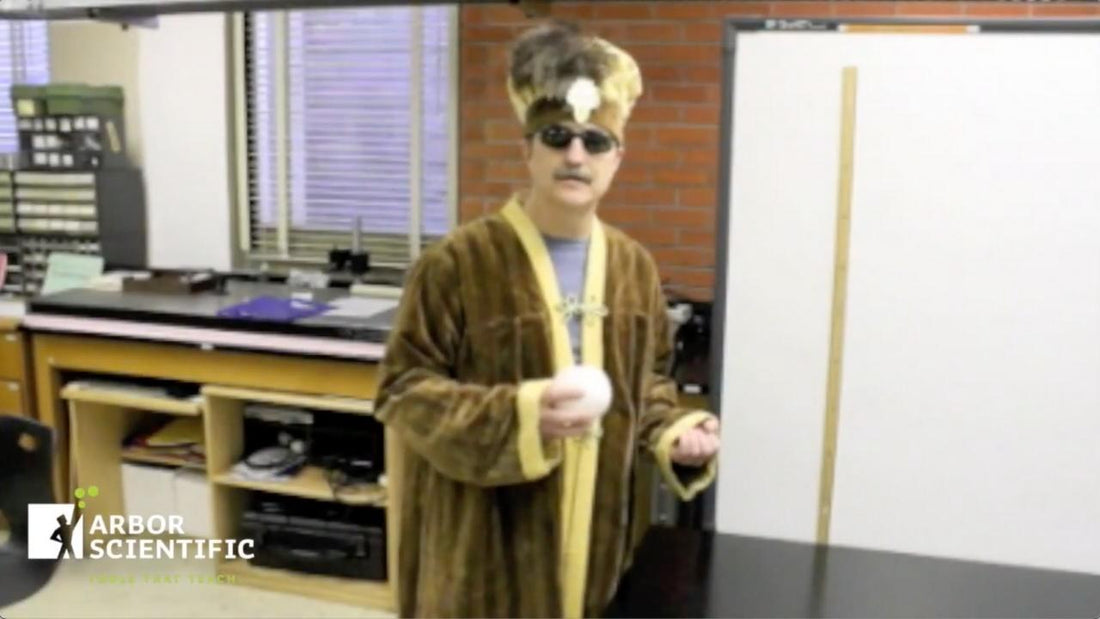Featured Products
What is this about?
Galileo claimed that all objects fall toward Earth with the same acceleration. Modern measurements indicate that this gravitational acceleration is about 9.81m/s2. Using the G-Ball by Arbor Scientific, you can measure this value and compare the acceleration of other objects with different masses and in different states of motion.
What do I need?
You need a G-Ball, a meter stick, and other objects to drop such as a baseball/softball.
What will I be doing?
First, you will measure the acceleration due to gravity by simply dropping the G-ball and getting the time to fall. Next, you'll throw the G-ball horizontally at different speed and see if the time of fall changes. Finally, you will drop the G-ball and a baseball to see which object accelerates more rapidly.
What do I think will happen?
Assume that you drop the G-ball from rest from an initial height of 1.0m. Use the accepted value of g = 9.8m/s2 and the kinematic equation to predict the time of fall. Did you get 0.45s?
If you toss the G-ball horizontally, at different speeds do you think:
- The time for the fall will increase if the G-ball is thrown faster.
- The time for the fall will stay the same if the G-ball is thrown faster.
- The time for the fall will decrease if the G-ball is thrown faster.
Take a moment to write down your thinking and explain your answer.
If you drop a G-ball and a baseball/softball at the same time which one will hit the ground first? Again, take a moment to write down your thinking to explain your answer.
What really happened?
- Following the instructions packaged with the G-ball, use it to time a fall of 1.0m.
- Repeat this process several times to get an average value.
- Comment on your value compared with your prediction.
- Time the fall for the G-ball tossed horizontally from a height of 1.0m.
- Repeat this tossing the ball horizontally at several different speeds.
- Do the values vary more than they did for the dropped G-ball? Comment on your results and compare them with your prediction.
- Drop a G-ball and a baseball from the same height at the same time.
- Repeat this several times until you are sure which one hits the ground first.
- Comment on your results compared with your prediction.
What did I learn?
If you found that the time for the fall was about 0.45s, then you have verified the accepted value of the acceleration due to gravity is 9.8m/s2. Did you discovered that regardless of the speed you threw the ball horizontally the time of the fall was the same? If so, you have shown that the horizontal motion does not affect the vertical motion. Finally, if you saw that all objects fall at the same rate, you have verified Galileo's experiment – just like he supposed did at the Tower of Pisa.
What else should I think about?
Why did you have to be careful to throw the ball horizontally? What would have happened if you accidentally gave the ball a slightly upward initial velocity? What about a slightly negative initial velocity?
If the mass of a falling object doesn't affect its motion, why does a feather fall slower that the g ball?
How is the force of gravity on an object related to gravitational acceleration?
Catch it in the Web!
The Brainiacs dropped cars to test Galileo's ideas about falling objects. Check it out!
A feather and a hammer were dropped at the same time on the moon. See the result!
Dr. David Kagan has been at CSU Chico for over thirty years. During this time, Dr. Kagan has served in numerous roles including: Chair of the Department of Physics; founding Chair of the Department of Science Education; and Assistant Dean in the College of Natural Sciences to name a few. He is a regular contributor to The Physics Teacher having had over thirty papers published in the journal. Kagan continues his deep devotion to quality teaching by avidly engaging his students with methodologies adapted from the findings of Physics Education Research. In addition, he has remained true to his lifelong obsession with baseball by using the national pastime to enhance the teaching and learning of physics.


